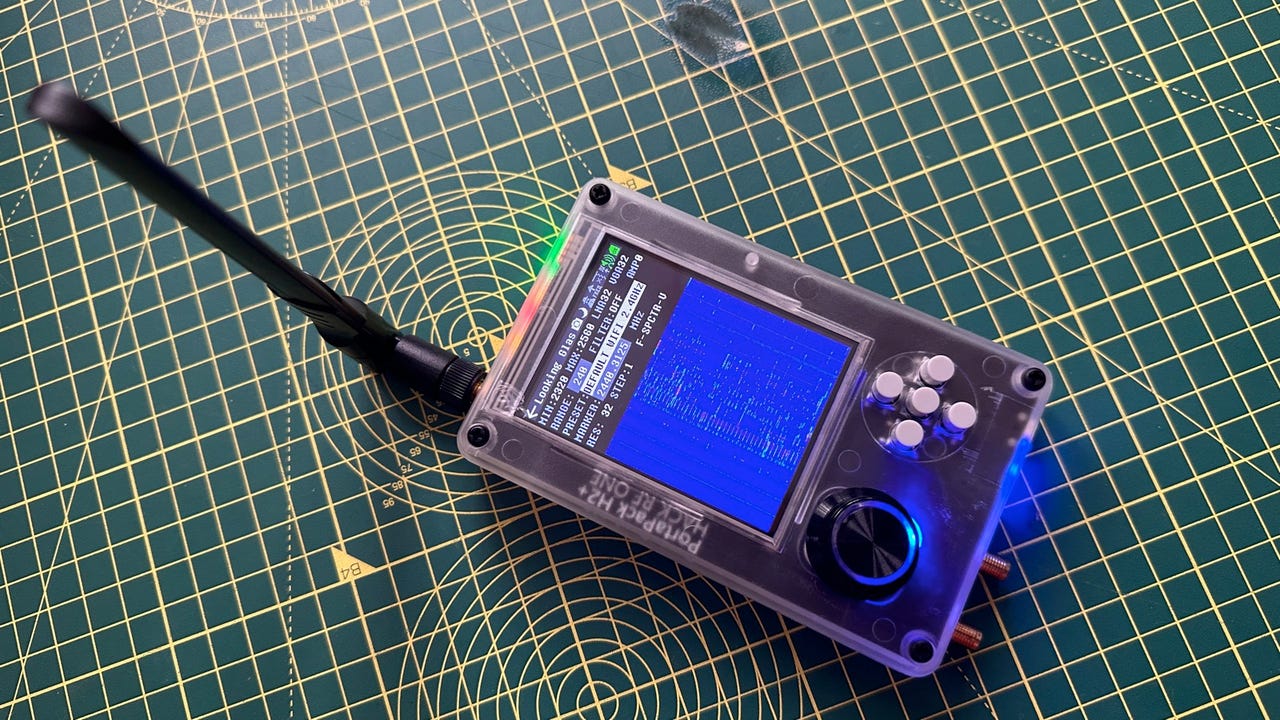
HackRF One/PortaPack H2 combo scanning the Wi-Fi radio spectrum
Adrian Kingsley-Hughes/ZDNET
I love my Flipper Zero. This is a $169 multifunctional device that can interact with digital interfaces in the physical world.
With it you can emulate RFID and NFC cards, analyze radio protocols, imitate remote controls, and much more. It’s like a “digital Swiss Army knife” for cybersecurity enthusiasts, tinkerers, and those interested in exploring the digital side of their environment.
Also: Teslas vulnerable to Flipper Zero hack – here’s how to protect yourself
If you’ve got one of these, then the next logical step for you is to get a HackRF One software defined radio, or SDR.
HackRF One, made by Great Scott Gadgets, is an SDR designed to capture and transmit radio signals from 1MHz to 6GHz.
HackRF One tech specs
- Transmit or receive any radio signal from 1 MHz to 6000 MHz
- Half-duplex transceiver
- Maximum sample rate: 20 million samples per second
- 8-bit quadrature samples
- High-speed microUSB interface
- Powered via USB
It’s a radio, but a radio that goes way beyond music and talk shows. This is a radio that can pick up Wi-Fi, signals from car keyfobs, Bluetooth, amateur radio, aircraft ADS-B and ship AIS signals, and much, much more. As for transmitting, the sky’s the limit, and anything you can capture, you can technically record and transmit.
You can also venture into areas such as jamming, but this again is a place you need to be extremely careful so as not to end up with the Men in Black knocking at your door.
Also: 7 cool and useful things to do with your Flipper Zero
If having a tool that gives you the ability to transmit and jam signals feels like it’s too rich for your blood because of the laws and regulations and rules that govern this, not to mention things like licenses, then you might be better off with an SDR that can only receive radio signals, something like the RTL-SDR Blog V3 SDR, which you can pick up for under $50.
You take your HackRF One, connect it to a computer, and capture data from the air with your favorite spectrum analysis software. There’s quite a steep learning curve here, actually dozens of steep learning curves, but fortunately, there’s a lot of good information on the web. A great setup guide can be found on the Hackers-Arise website (where you can also find some of the very best real-world cybersecurity training available).
Also: Flipper Zero and Raspberry Pi join forces to release Video Game Module
If you like the idea of the HackRF One, but don’t like the idea of needing to hook it up to a laptop, then there’s a more portable option in the form of a HackRF One combined with a PortaPack H2.
Combining the HackRF One and the PortaPack H2 adds a battery, touchscreen, buttons, and more, freeing you from the need to have a laptop. The PortaPack runs Mayhem firmware, and this package can do a lot of cool things.
HackRF One/PortaPack H2 combo running Mayhem.
Adrian Kingsley-Hughes/ZDNET
This, of course, adds more steep learning curves.
Also: Do you need an anti-spy camera finder and bug detector? Do they even work?
You can do so much with the HackRF One/PortaPack H2 combo that it frankly feels like you get given a superpower! It’s really just limited by your imagination and know-how. Just the other day I used mine to simulate an RF bugging device to test a spy-camera finder/bug detector.
Testing the RF detector in a spy camera/bug finder using a HackRF One/PortaPack H2 combo
Adrian Kingsley-Hughes/ZDNET
Also note that the HackRF One isn’t a replacement for the Flipper Zero, but a tool that allows you to explore the radio side deeper. The Flipper Zero is still a fantastic tool for playing with NFC and RFID, and for acting as an infrared remote.




















+ There are no comments
Add yours